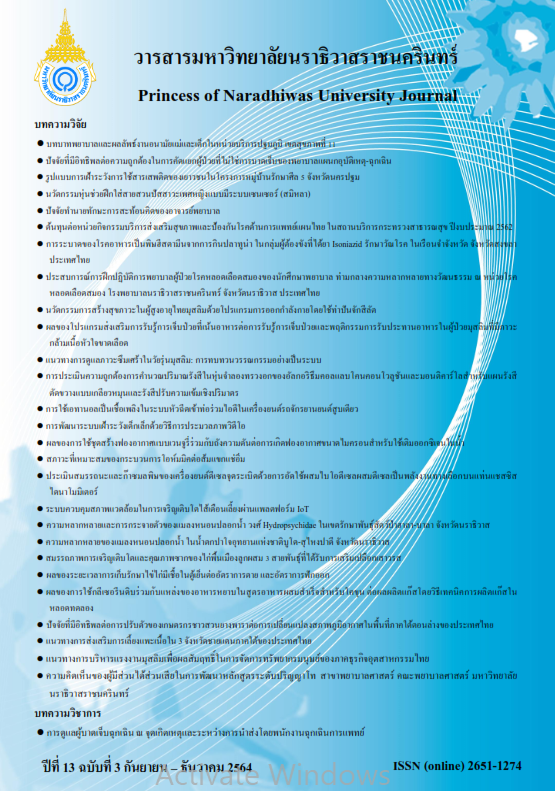A Model of Surveillance Behavior Patterns of Youth in the Five Precepts Keeping Village Project at Nakhon Pathom Province
Keywords:
Model of Surveillance, , Substance, Five Precepts Keeping Village Project, YouthAbstract
This research aimed to create a model of surveillance behavior patterns of youth substance use in the Five Precepts Keeping Village Project, Nakhon Pathom Province. A mixed-methods research design was conducted. The 1st phase was to investigate factors related to the use of addictive substance among 302 youths aged 15 - 21 years, and the data were analyzed by Multiple Regression. Then the qualitative method was involved in studying causes of the problem; a model of surveillance behavior patterns was developed. The qualitative data were analyzed by thematic analysis with data triangulation verification. The results found that the self-control of drug use, holistic health, perceived ability, self-efficacy in substance abuse prevention were the determinants to predict the use of addictive substance among youths in the five precepts village. Moreover, the model of surveillance behavior patterns of youth substance use consisted of 2 programs: (1) the development plan for the individual’s capabilities, consisting of plans to organize a public hearing, set up youth leader group, provide career training, provide supports in sport and health recreation activities and build awareness in media perception, and (2 the environmental adjustment plan consisting of exchange of ideas between parents or guardians, community leaders, teachers and religious leaders to discuss about prevention of drug in the community and plan to set up mind and wisdom development center based on 5-precepts concepts.
References
Bureau of Drug Prevention and Development. (2015). Conclusion of the progress of the implementation of the indicators goals according to the strategic plan of the land force over drugs. Nonthaburi: Bureau of Drug Prevention and Development. (in Thai).
Creswell, J. W. (2018). Research Design: Qualitative, Quantitative, and Mixed Methods Approaches. Thousand Oaks: Sage.
Dyer, J. H., & Nobeoka, K. (2000). Creating and managing a high- performance knowledge-Sharing network. Journal of Toyota Strategic Management, 21(3), 345-367.
Green, A., & Kreuter, L. (1999). Health Promotion Planning: An Education and Environmental Approach. Toronto: Mayfield Publishing.
Leaudnakrob, N., Sengsri, S., & Poltana, P. (2018). ICT: Information technology supported transformative learning. Journal of Boromarajonani College of Nursing, Uttaradit, 9(1), 70-80.
Nittaya, Y. (2013). Factors affecting the mathayomsuksa1students behavior of drugs prevention in schools under Loei primary educational service area. (M.Ed. Thesis in Educational). Loei Rajabhat University, Loei. (in Thai)
Office of the Narcotics Control Board. (2017). Brief history of drug addiction in 2017.Bangkok: Office of Narcotics Control Board. (in Thai)
Office of the Narcotics Control Board. (2018). Brief history of drug addiction in 2018.Bangkok: Office of Narcotics Control Board. (in Thai)
Office of the National Economic and Social Development Council. (2019). Retrieved from https://www.nesdb.go.th/main.php?filename=index.
Prachit, C. (2017). Buddha’s Doctrines with The Protection and Solution to the Narcotic’s Problems of The Youth. Journal of Philosophical Vision, 10(1), 12-27.
Salamteh, S. (2018). The development of juvenile leadership training curriculum of the Juvenile and family court for children and youth to prevent drug addiction. Journal of Humanities and Social Sciences Thonburi University, Special(12), 93-106.
Santrock, W. J. (1996). Adolescence.New York: Times mirror Higher Education.
Suthep, P. (2019). The Buddhist Doctrines to Prevent Criminal Behavior of Children and Young People in Bangkok. Journal of MBU Education, 36(2), 78-87.
Snowden, D. (2005). From atomism to networks in social system. The Learning Organization, 12(6), 552-562.
Sudarat, P. B. (2018). Mediating Role of Mindfulness on the Relationship between Stress and Substance Use in Secondary School Students. Journal of Nursing Science, 7(1), 85-106.
Tafa, M., & Baiocco, R. (2009). Addictive Behavior and family functioning during adolescence. Journal of Family Therapy, 37(1), 388-395.
Teddlie, C., & Tashakkori, A. (2009). Foundation of mixed methods research: Integrating quantitative and qualitative approaches in the social and behavioral science. Los Angeles: SAGE.
Thasingern, P. (2015). Guidelines for the cooperation building of drug prevention and solution of the community leaders in Uttaradit province. Journal of Graduate School, 10(1), 67-76.
United Nations Office on Drugs and Crime. (2018). World drug report 2018. Geneva: United Nations Office on Drugs and Crime.




